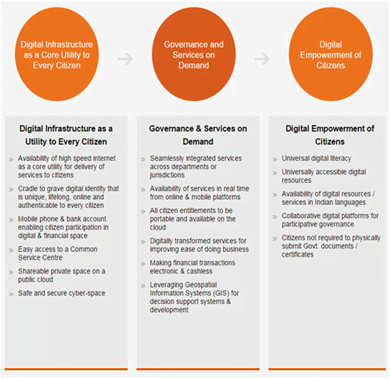Governance
Context: The Digital India Programme has made the country digitally empowered in the area of technology and innovation.
About the Digital India programme:
Digital India is a flagship programme of the Government of India with a vision to transform India into a digitally empowered society and knowledge economy. The programme was launched on July 1, 2015 by Hon’ Prime Minister Shri Narendra Modi.

Outcomes of the programme:
- Digital India has considerably reduced the distance between the Government and citizens.
- It has also helped in the delivery of substantial services directly to the beneficiary in a transparent and corruption-free manner.
- In the process, India has emerged as one of the pre-eminent nations of the world to use technology to transform the lives of its citizens.
Significance of the Digital India campaign
- Transparency: The transparency that has come due to Digital India has eliminated corruption at various levels adversely affecting the poor and the middle class.
- Direct Benefit Transfer: In the last eight years, more than Rs 23 lakh crore has been transferred through Direct Benefit Transfer (DBT) to beneficiaries.
- The trio of Jan Dhan, Mobile and Aadhaar, or JAM: It has provided maximum benefit to the poor and the middle class.
- Ending corruption: The Digital India campaign has helped save Rs 2.25 lakh crore from falling into the wrong hands in the past eight years.
- Eliminating middle-men: Digital India has saved money for the common man by ending the network of middle-men
- Digital India helped the government tackle the crisis arising out of the Covid pandemic: CoWin and Aarogya Setu are two mobile applications that helped provide 200 crore vaccine doses.
- Ending digital divide: Digital India has also helped bridge the digital divide that exists between rural and urban India.
Challenges:
- Gender gap: Indian women are 15 per cent less likely to own a mobile phone and 33 per cent less likely to use mobile internet services than men.
- Women constitute only one-third of internet users in India.
- Skewed penetration: Among states, Maharashtra has the highest internet penetration, followed by Goa and Kerala, while Bihar has the lowest, followed by Chhattisgarh and Jharkhand.
- India’s global rank: According to the UN’s e-participation index (2022), which is a composite measure of three important dimensions of e-government, namely provision of online services, telecommunication connectivity and human capacity, India ranks 105 out of 193 nations.
- Online safety: According to a survey, more than half of young women have experienced violence online, including sexual harassment, threatening messages and having private images shared without consent.
- Women’s rights defenders and female journalists were targeted for abuse more than most.
- Inadequate artificial intelligence: The third threat comes from badly designed artificial intelligence systems that repeat and exacerbate discrimination.
Key initiatives undertaken by MeitY under the Digital India programme:
- Aadhaar: Aadhaar provides 12 digits biometric and demographic-based identity that is unique, lifelong, online and authenticable.
- It has also given statutory backing through The Aadhaar (Targeted Delivery of Financial and Other Subsidies, Benefits and Services) Act, 2016.
- Over 135.5 crore residents have been enrolled.
- Unified Mobile Application for New-age Governance (UMANG): For providing government services to citizens through mobile. More than 1668 e-Services and over 20,197 bill payment services are made available at UMANG.
- Common Services Centres: CSCs are offering government and business services in digital mode in rural areas through Village Level Entrepreneurs (VLEs).
- Over 400 digital services are being offered by these CSCs.
- So far, 5.21 Lakh CSCs are functional (including urban & rural areas) across the country.
- Unified Payment Interface (UPI): It is the leading digital payment platform. It has onboarded 376 banks and has facilitated 730 crore transactions (by volume) worth Rs 11.9 lakh crore.
- Digi Locker: Digital Locker provides an ecosystem with the collection of repositories and gateways for issuers to upload the documents in the digital repositories.
- Digital Locker has more than 13.7 crore users and more than 562 crore documents.
- e-Sign: e-Sign service facilitates instant signing of forms/documents online by citizens in a legally acceptable form.
- MyGov: It is a citizen engagement platform that is developed to facilitate participatory governance. Presently, over 2.76+ crore users are registered with MyGov.
- MeriPehchaan: National Single Sign-on (NSSO) platform called MeriPehchaan has been launched in July 2022 to facilitate/provide citizens ease of access to government portals.
- Jeevan Pramaan: Jeevan Pramaan envisages digitizing the whole process of securing the life certificate for pensioners.
- Pradhan Mantri Gramin Digital Saksharta Abhiyaan (PMGDISHA): The Government has approved the scheme to usher in digital literacy in rural India.
Way Forward:
Need of the hour is to establish an empowered entity needs to be set up which is accountable for quality and timeliness to design and construct digital highways, and their rural branches, and ensure their optimum utilisation by sharing the infrastructure. Digital skills, required today both for life and for livelihoods, must be imparted on a war footing by transforming government digital literacy programmes into skilling missions, and expanding outreach, including through the private sector.
The Social media sites can use their “algorithm power” to proactively tackle the issue of safety. Thus, the government needs to strengthen laws that hold online abusers to account, and the public to speak up whenever they witnessed abuse online.
Source: The Hindu











